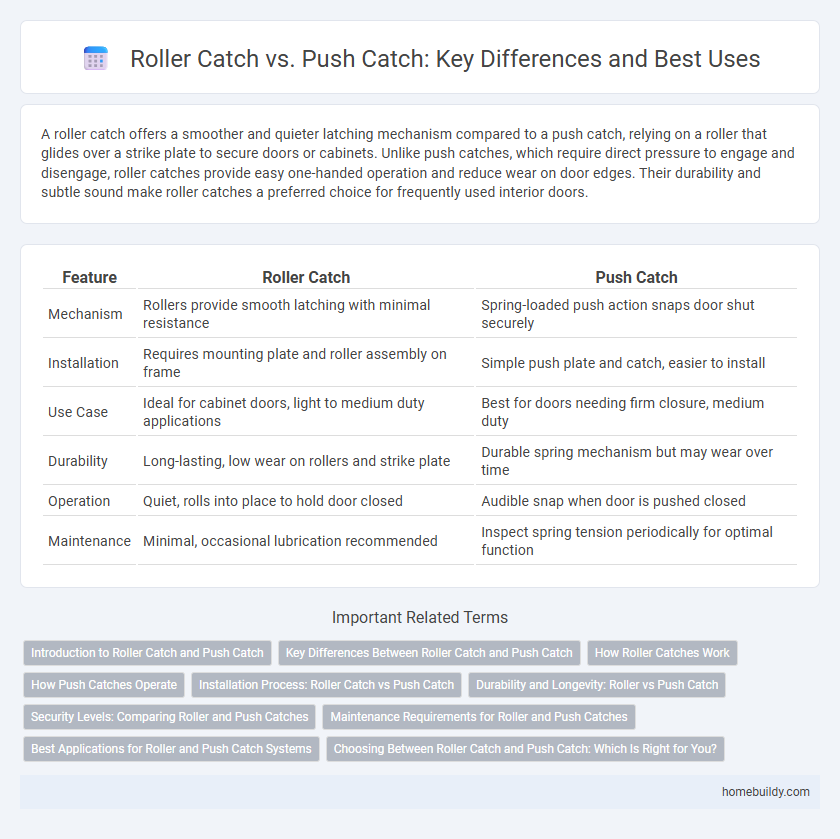A roller catch offers a smoother and quieter latching mechanism compared to a push catch, relying on a roller that glides over a strike plate to secure doors or cabinets. Unlike push catches, which require direct pressure to engage and disengage, roller catches provide easy one-handed operation and reduce wear on door edges. Their durability and subtle sound make roller catches a preferred choice for frequently used interior doors.
Table of Comparison
| Feature | Roller Catch | Push Catch |
|---|---|---|
| Mechanism | Rollers provide smooth latching with minimal resistance | Spring-loaded push action snaps door shut securely |
| Installation | Requires mounting plate and roller assembly on frame | Simple push plate and catch, easier to install |
| Use Case | Ideal for cabinet doors, light to medium duty applications | Best for doors needing firm closure, medium duty |
| Durability | Long-lasting, low wear on rollers and strike plate | Durable spring mechanism but may wear over time |
| Operation | Quiet, rolls into place to hold door closed | Audible snap when door is pushed closed |
| Maintenance | Minimal, occasional lubrication recommended | Inspect spring tension periodically for optimal function |
Introduction to Roller Catch and Push Catch
Roller catches feature a spring-loaded roller mechanism that secures doors with smooth engagement and quiet operation, ideal for cabinet and closet doors. Push catches rely on a push-to-open mechanism, using a spring plunger that releases with a slight push, offering a clean, handle-free appearance. Choosing between roller catches and push catches depends on desired ease of use, door type, and aesthetic preferences.
Key Differences Between Roller Catch and Push Catch
Roller catches use rotating rollers to secure doors with smooth engagement and quieter operation, offering adjustable tension for customized hold strength. Push catches rely on spring-loaded mechanisms that require direct pushing to release, providing a firmer latch but often producing louder clicks when engaged or disengaged. Roller catches excel in applications needing gentle closure and easy door movement, while push catches are preferred for strong, secure latching in high-traffic or heavy-use areas.
How Roller Catches Work
Roller catches function by using a spring-loaded roller that grips a strike plate, providing a secure yet easily releasable hold on doors or cabinets. Unlike push catches, which rely on a push mechanism to latch and unlatch, roller catches utilize rotational friction to maintain door closure without the need for buttons or levers. This mechanism offers smooth operation, durability, and is ideal for applications where quiet, non-locking retention is required.
How Push Catches Operate
Push catches operate through a spring-loaded mechanism that engages with a strike plate, securing doors firmly while allowing easy release with a simple push. Unlike roller catches, which rely on rotating rollers to hold the door, push catches provide consistent and quiet closure without requiring precise alignment. This mechanism is especially effective in cabinetry and lightweight doors where a streamlined engagement and disengagement process is essential.
Installation Process: Roller Catch vs Push Catch
Roller catches offer a straightforward installation process requiring precise alignment of the roller mechanism and strike plate for smooth latching, often suited for interior doors. Push catches typically involve simpler mounting with adhesive or basic screws, making them ideal for lightweight applications such as cabinet doors. Proper tool selection and measurement accuracy are critical for both types to ensure effective door closure and durability.
Durability and Longevity: Roller vs Push Catch
Roller catches offer superior durability compared to push catches due to their robust construction with cylindrical rollers that reduce metal-on-metal wear. Push catches rely on spring tension, which can weaken over time, leading to decreased longevity and less secure closure. The roller mechanism's resistance to repeated impact ensures extended service life in high-traffic applications.
Security Levels: Comparing Roller and Push Catches
Roller catches provide a moderate level of security by using spring-loaded rollers to firmly hold doors in place, making them suitable for interior doors that require easy access with some retention. Push catches rely on a simple push mechanism that engages a latch, offering minimal security ideal for lightweight cabinet doors or panels where convenience is prioritized over protection. Comparing security levels, roller catches outperform push catches by providing more reliable resistance against accidental openings and minor forced entry.
Maintenance Requirements for Roller and Push Catches
Roller catches require regular lubrication and cleaning to maintain smooth operation and prevent wear on the roller mechanism, whereas push catches demand less frequent maintenance but may need periodic adjustment to ensure proper engagement and release. The mechanical complexity of roller catches necessitates closer monitoring of moving parts compared to the simpler design of push catches, which rely on spring tension and push-in action. Both types benefit from inspection for debris buildup and alignment checks, but roller catches typically present higher maintenance due to their rolling components.
Best Applications for Roller and Push Catch Systems
Roller catch systems excel in applications requiring smooth, quiet door latching with moderate holding force, making them ideal for interior cabinet doors and wardrobe enclosures. Push catch systems provide a more secure hold without handles, perfect for minimalist designs and frequently used doors that demand easy, one-handed operation. Selecting between roller and push catch systems depends on factors such as door weight, frequency of use, and aesthetic requirements in residential or commercial furniture.
Choosing Between Roller Catch and Push Catch: Which Is Right for You?
Choosing between roller catch and push catch depends on the desired door function and ease of use. Roller catches provide smooth, adjustable holding strength and are ideal for lightweight doors, while push catches offer a firm, snap-close mechanism suitable for cabinets requiring secure closure without handles. Consider door material, frequency of use, and installation complexity to determine the most practical and efficient option for your project.
roller catch vs push catch Infographic

 homebuildy.com
homebuildy.com